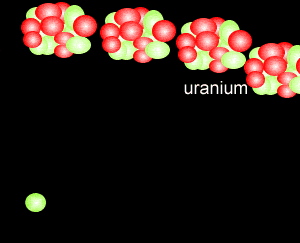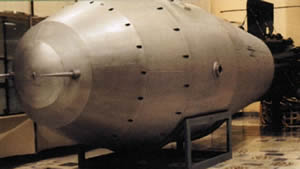 |
Hydrogen bomb The Tsar Bomba |
The largest, most powerful nuclear weapon ever detonated was developed by the Soviet Union, known as the Tsar bomba. This weapon was originally designed to have a yield of about 100 megatons of TNT but this was scaled back to 50 megatons to reduce the radioactive fallout. It was detonated on October 30, 1961. This weapon was not developed as part of the Soviet weaponry but intended to demonstrate the capabilities of the Soviets at the time. Despite testing, the weapon never entered service; it was simply a demonstration of the capabilities of the Soviet Union's military technology at the time. After detonation the fireball reached from the ground to an altitude of 10 km while the mushroom cloud reached an altitude of 64 km. |
|
| The bomb was 8 m long and carried to its target by a modified bomber. Such a slow flying plane could be easily shot out of the sky during a conflict. Hence a large weapon, like this one, was passed over in preference to smaller nuclear devices that can be delivered quickly by missiles. |
|
A simple explanation will be given which involves nuclear fusion. Nuclear fusion is the reaction that fuels the sun. It involves the fusion of hydrogen atoms to form a helium atom. |
|
To increase the yield of the bomb the metal cover is made of uranium As the neutrons fly away from the newly formed helium they collide with the uranium coat initiating a nuclear fission reaction and the release of a greater amount of energy. This however results in a great deal of radioactive material expelled into the atmosphere. The soviets deliberately reduced the capacity of the bomb by placing a lead casing around the bomb rather than a uranium one. Bombs without the uranium casing release a lot of energy and neutrons and are known as neutron bombs. |
 |
What are isotopes? The nucleus of a deuterium atom has how many protons and neutrons? The nucleus of a tritium atom has how many protons and neutrons? What element is produced in the sun from the fusion of hydrogen nuclei? What conditions must be created to fuse hydrogen atoms together? How are these conditions formed? Why is a hydrogen bomb considered to be cleaner than a fission bomb? Why was the yield decreased by placing a lead casing around the bomb as opposed to a uranium casing? |
|

